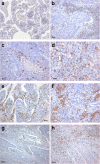Immune cell landscape in therapy-naïve squamous cell and adenocarcinomas of the lung
- PMID: 29520483
- PMCID: PMC5924661
- DOI: 10.1007/s00428-018-2326-0
Immune cell landscape in therapy-naïve squamous cell and adenocarcinomas of the lung
Abstract
Squamous cell and adenocarcinomas of the lung develop different mechanisms during carcinogenesis to evade attacks of the immune system. Besides the well-known check-point control programmed death 1 and its ligand, many more mechanisms, acting either tumoricidal or in favor of tumor progression, exist. Analysis of the immune cell profiles in resected tissues and bronchoalveolar lavage samples and correlation between them and with overall survival data was performed. In all tumor samples in this study, cells of the immune system expressed a tumor-cooperating phenotype. High numbers of regulatory T cells, or alternatively expression of Vista on lymphocytes was present. Tumoricidal dendritic cells were absent in tumor tissue, and barely present in bronchoalveolar lavage, whereas tumor-friendly monocytoid and plasmocytoid dendritic cells were seen in both. Alveolar macrophages were predominantly differentiated into tumor-cooperating M2 types, whereas tumoricidal M1 macrophages were absent or rare. The expression of PDL1 on tumor cells did not correlate with any other immune cells. Expression of PD1 on lymphocytes was frequently encountered. None of analyzed immune cells showed correlation with overall survival. Immune cells in bronchoalveolar lavage and tissue did not correlate. For the first time, a tissue-based analysis of different immune cells in squamous cell and adenocarcinomas of the lung is provided, trying to explain their potential role in tumor development and progression. Discordant numbers of cells with bronchoalveolar lavage are most probably due to the fact that bronchoalveolar lavage reflects the situation in the whole lung, where chronic obstructive lung disease and other conditions are present.
Keywords: Bronchoalveolar lavage; Dendritic cells; Immune cells; Immune system; Myeloid-derived suppressor cells; Non-small-cell lung cancer.
Conflict of interest statement
Conflict of interest
The authors declare that they have no conflict of interest.
Figures

References
-
- Antonios JP, Soto H, Everson RG, Moughon D, Orpilla JR, Shin NP, Sedighim S, Treger J, Odesa S, Tucker A, Yong WH, Li G, Cloughesy TF, Liau LM, Prins RM (2017) Immunosuppressive tumor-infiltrating myeloid cells mediate adaptive immune resistance via a PD-1/PD-L1 mechanism in glioblastoma. Neuro Oncol. 10.1093/neuonc/now287 - PMC - PubMed
-
- Berghoff AS, Fuchs E, Ricken G, Mlecnik B, Bindea G, Spanberger T, Hackl M, Widhalm G, Dieckmann K, Prayer D, Bilocq A, Heinzl H, Zielinski C, Bartsch R, Birner P, Galon J, Preusser M. Density of tumor-infiltrating lymphocytes correlates with extent of brain edema and overall survival time in patients with brain metastases. Oncoimmunology. 2016;5:e1057388. doi: 10.1080/2162402X.2015.1057388. - DOI - PMC - PubMed
-
- Blidner AG, Salatino M, Mascanfroni ID, Diament MJ, Bal de Kier Joffe E, Jasnis MA, Klein SM, Rabinovich GA. Differential response of myeloid-derived suppressor cells to the nonsteroidal anti-inflammatory agent indomethacin in tumor-associated and tumor-free microenvironments. J Immunol. 2015;194:3452–3462. doi: 10.4049/jimmunol.1401144. - DOI - PubMed
MeSH terms
LinkOut - more resources
Full Text Sources
Other Literature Sources
Medical
Research Materials

